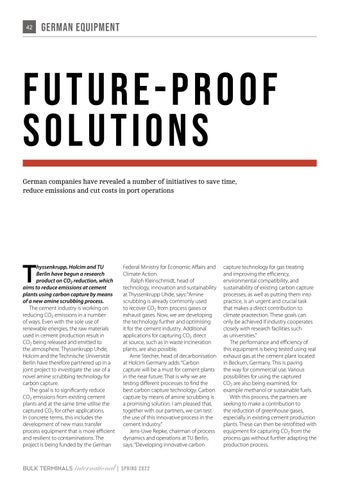42
german equipment
FUTURE-PROOF SOLUTIONS German companies have revealed a number of initiatives to save time, reduce emissions and cut costs in port operations
T
hyssenkrupp, Holcim and TU Berlin have begun a research product on CO2 reduction, which aims to reduce emissions at cement plants using carbon capture by means of a new amine scrubbing process. The cement industry is working on reducing CO2 emissions in a number of ways. Even with the sole use of renewable energies, the raw materials used in cement production result in CO2 being released and emitted to the atmosphere. Thyssenkrupp Uhde, Holcim and the Technische Universität Berlin have therefore partnered up in a joint project to investigate the use of a novel amine scrubbing technology for carbon capture. The goal is to significantly reduce CO2 emissions from existing cement plants and at the same time utilise the captured CO2 for other applications. In concrete terms, this includes the development of new mass transfer process equipment that is more efficient and resilient to contaminations. The project is being funded by the German
BULK TERMINALS
Federal Ministry for Economic Affairs and Climate Action. Ralph Kleinschmidt, head of technology, innovation and sustainability at Thyssenkrupp Uhde, says: “Amine scrubbing is already commonly used to recover CO2 from process gases or exhaust gases. Now, we are developing the technology further and optimising it for the cement industry. Additional applications for capturing CO2 direct at source, such as in waste incineration plants, are also possible. Arne Stecher, head of decarbonisation at Holcim Germany adds: “Carbon capture will be a must for cement plants in the near future. That is why we are testing different processes to find the best carbon capture technology. Carbon capture by means of amine scrubbing is a promising solution. I am pleased that, together with our partners, we can test the use of this innovative process in the cement industry.” Jens-Uwe Repke, chairman of process dynamics and operations at TU Berlin, says: “Developing innovative carbon
international | SPRING 2022
capture technology for gas treating and improving the efficiency, environmental compatibility, and sustainability of existing carbon capture processes, as well as putting them into practice, is an urgent and crucial task that makes a direct contribution to climate praotection. These goals can only be achieved if industry cooperates closely with research facilities such as universities.” The performance and efficiency of this equipment is being tested using real exhaust gas at the cement plant located in Beckum, Germany. This is paving the way for commercial use. Various possibilities for using the captured CO2 are also being examined, for example methanol or sustainable fuels. With this process, the partners are seeking to make a contribution to the reduction of greenhouse gases, especially in existing cement production plants. These can then be retrofitted with equipment for capturing CO2 from the process gas without further adapting the production process.














